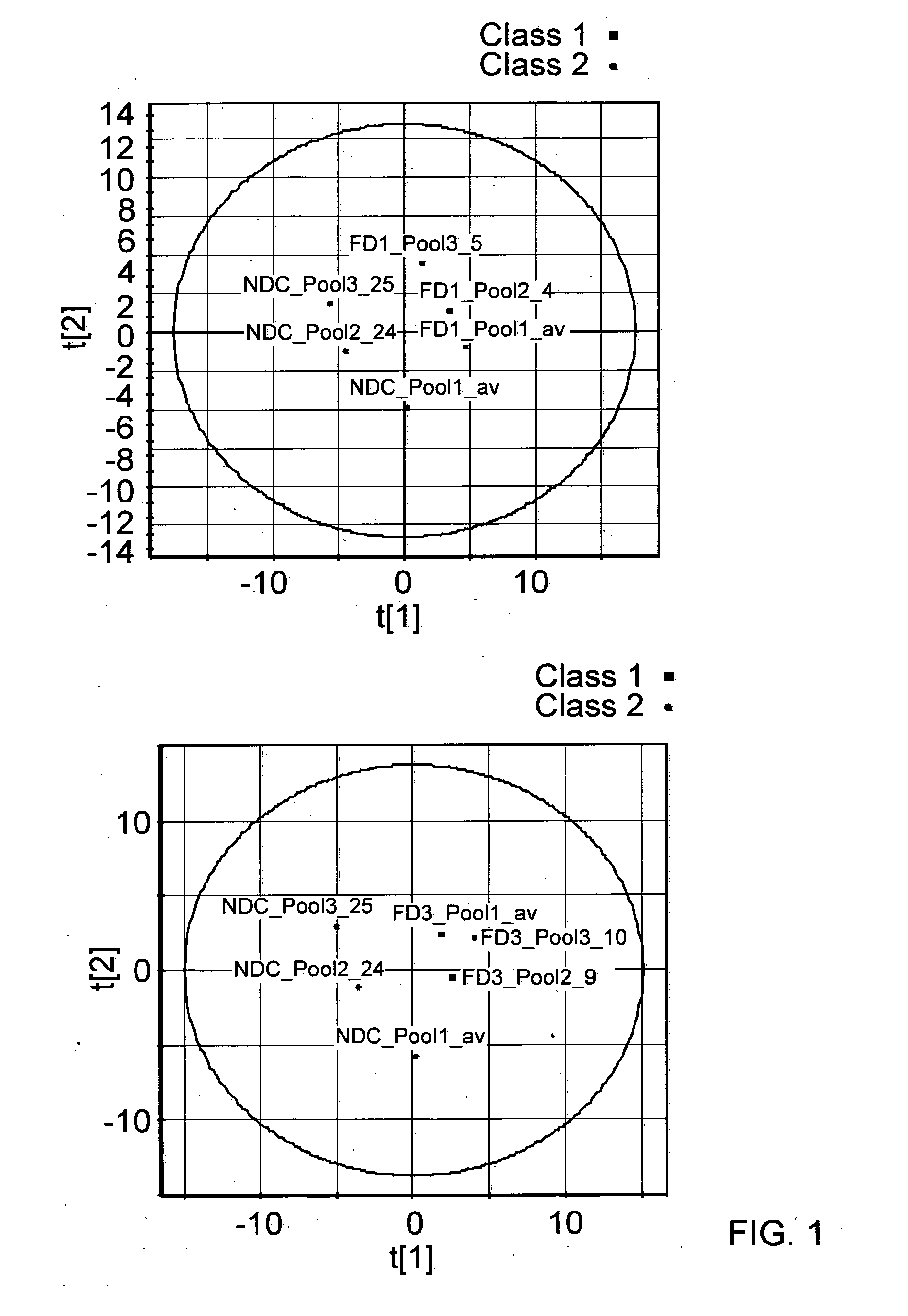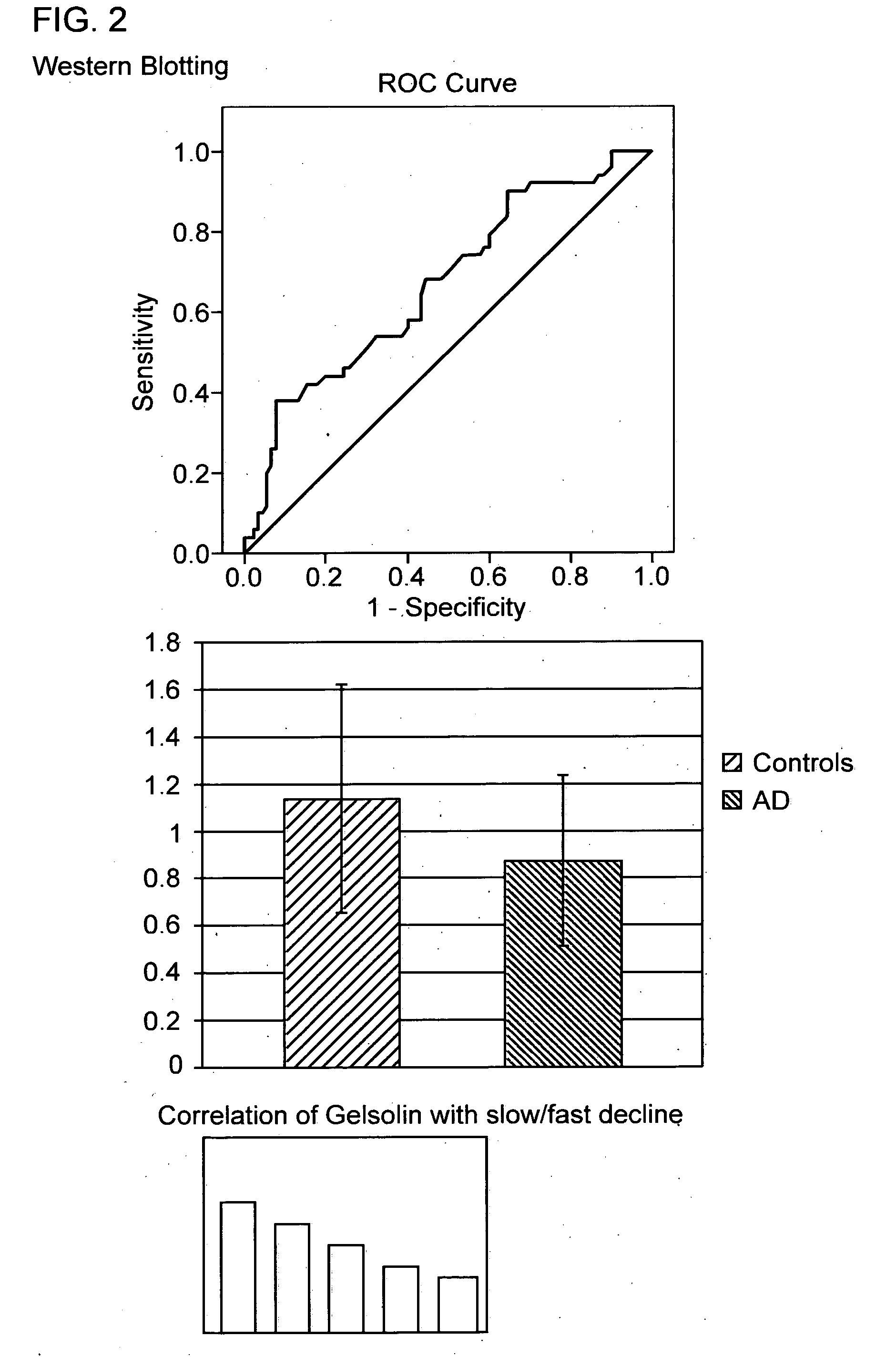Methods
- Summary
- Abstract
- Description
- Claims
- Application Information
AI Technical Summary
Benefits of technology
Problems solved by technology
Method used
Image
Examples
example 1
Selection of Subjects and Pools
[0227]The population of the main study was derived from a largely community based population of subjects with Alzheimer's disease and elderly people [Alzheimer's Research Trust (ART) cohort] and were assessed by several cognitive measures including mini mental state examination (MMSE) scale and Alzheimer's disease assessment scale-cognitive subscale (ADAS-cog). The samples were matched for age, gender and baseline MMSE scores between groups and for age, gender and MMSE decline within groups. Samples were collected into EDTA coated glass tubes and stored at −80° C. until further analysis.
[0228]For the discovery experiment, plasma samples were analysed from FD and SND groups at baseline (year 1) and after two years (year 3); a single plasma sample was collected from each subject in the NDC group. A total of 15 samples were available per group (75 samples in total) and these were pooled into three sets each of five samples. This results in a total of 15 p...
example 2
[0230]In example 3, protein detection by isobaric protein labelling is demonstrated. This example explains how the sample may advantageously be prepared for such an analysis. Of course if a different analysis is used, then a different sample preparation might be chosen.
[0231]In general, sample preparation and labelling with tandem mass tags (TMT) was performed as previously described (Dayon et al., 2008) with minor modifications. To increase the number of detectable proteins, plasma was depleted of the six highest abundant proteins (albumin, transferrin, IgG, IgA, antitrypsin, and haptoglobin) with a multiple affinity removal system (MARS, 5188-5332, Agilent, Palo Alto, Calif.). 300 of pooled plasma were diluted 1:4 by the addition of 900 MARS buffer A, vortexed and spinned down for 1 min at 15,500×g. 100 μl of the supernatant was injected on a 4.6 mm×50 mm MARS column and processed according to the manufacturers instructions. The flow through fractions (1 ml) were...
example 3
Protein Detection
[0232]In principle, protein detection may be by any suitable means known to the skilled reader. The Isobaric Protein Tagging technique is now described by way of example.
[0233]To ensure equal protein amounts, 100 μg of protein per sample were transferred to a new tube, 5 μl 2% SDS in H2O (w:w) were added and filled up to 100 μl with 100 mM TEAB. 5.3 μl 20 mM Tris(2-carboxyethyl)phosphine hydrochloride (TCEP) in H2O were added and incubated for 30 min at room temperature (RT). Afterwards, 5.5 μl 150 mM iodoacetamide in acetonitrile (ACN) were added and incubated in the dark for 60 min at RT. Subsequently, 104 of freshly prepared trypsin (Seq. grad modified trypsin, Promega, V5111, Madison, Wis., USA) at 0.4 μg / μl in 100 mM TEAB were added and incubated overnight at 37° C.
[0234]The 15 plasma pools were split for analysis into three individual experiments (biological replicates), whereas one of these experiments was repeated three times for technical replication. In ea...
PUM
| Property | Measurement | Unit |
|---|---|---|
| Fraction | aaaaa | aaaaa |
| Fraction | aaaaa | aaaaa |
| Fraction | aaaaa | aaaaa |
Abstract
Description
Claims
Application Information
 Login to View More
Login to View More - R&D
- Intellectual Property
- Life Sciences
- Materials
- Tech Scout
- Unparalleled Data Quality
- Higher Quality Content
- 60% Fewer Hallucinations
Browse by: Latest US Patents, China's latest patents, Technical Efficacy Thesaurus, Application Domain, Technology Topic, Popular Technical Reports.
© 2025 PatSnap. All rights reserved.Legal|Privacy policy|Modern Slavery Act Transparency Statement|Sitemap|About US| Contact US: help@patsnap.com



